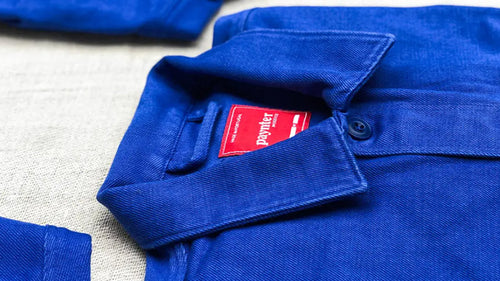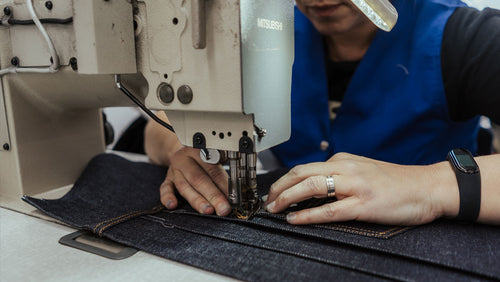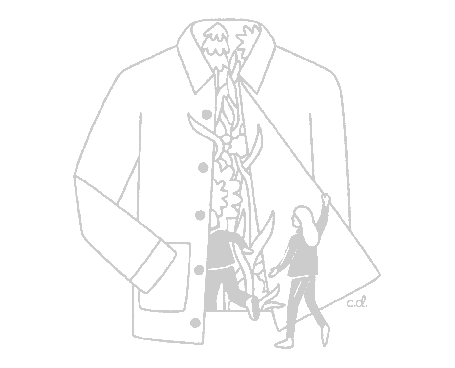When it comes to iconic workwear staples, few jackets provide the timeless, functional and handsome style of the trusty chore coat. Much like blue jeans, the hardy piece of outerwear has evolved over the past century from a practical uniform worn by blue collar labourers to become an everyday staple for men and women around the world.
![]()
The universal appeal of the jacket lies in its simple, practical design and throw-on appeal that has made it a go to for everyone from farmers and ranchers in rural America to streetwear enthusiasts and Haggerston hipsters alike. More than just a shield of harsh weather and heavy duty work, the chore coat has become a symbol of unity - especially in this politically polarising era. It’s a piece that crosses socio economic, geographical and political lines and age demographics. Celebrities such as Kanye West and Justin Bieber’s wife Hayley Bieber are frequently photographed in the same vintage jackets as the dusty construction worker on the subway. With such a broad appeal, it's no wonder that OG brands like Carhartt, Levi’s and Vétra keep heritage styles in their core collections, while labels like Junya Watanabe, Heron Preston and Loewe use it as a point of reference for their seasonal runway shows.
The chore coat certainly isn’t tied to a particular time of year - one of the best things about the item is its transseasonal style. But given fashion's ongoing fixation with workwear and the arrival of spring, there's never been a better time to think about investing in a good medium-weight jacket. To help you better understand the jacket and its origins, we’ve compiled and essential guide to the chore detailing everything you need to know from its details to its evolutions through contemporary culture.

What defines a chore coat?
Chore coat, barn coat, utility jacket and worker jacket are names you’ve probably seen thrown about online or heard in discussions when describing this practical jacket. While there are many iterations, they all seek to describe more or less the same garment. The quintessential design is defined by a boxy silhouette with large patch pockets on the chest and hips. It’s a jacket of blue-collar origins, as the name suggests, that's why they’re typically built from sturdy twill or canvas and reinforced with rivets or double needle topstitching.
The origins

c/o The Vintage Showroom
The chore coat first emerged in 19th-century France, where it became the daily uniform for laborers, railroad engineers and farmers. The most recognisable, classic jackets we’ve come to know were made from durable cotton drill or moleskin - locally known as Toile de Chine. Fabric mills dyed the jackets with a distinctive rich French benzoate based blue dye - a colour selected as it would mask the dirt and stains from daily work. The jackets were so prevalent throughout France that they became referred to as bleu de travail which translates directly to ‘blue work’. This is also where the term “blue-collar worker” first emerged.
As well as being a tough outerwear piece, the jacket was constructed with functional details like easy-button fastenings and oversized pockets that could store essential tools and objects that the workers would need on the job.
America christens the chore coat
According to denim historian Mohsin Sajid of Denim History, it wasn’t until the bleu de travail reached the United States that it would be coined with its commonly known name, the chore coat. The practical jacket featured many of the signature details of its predecessor, but did not come in the same vibrant blue of its French cousin. Instead many of the early workwear brands like The Boss and Pointer Brand rendered their versions in sturdy fabrics like duck canvas, denim, herringbone twill and sailcloth drill.

It’s not exactly clear who made the first American chore coat as there was a lot of cross pollination between many of the dry goods brands at the time. Levi’s is a name synonymous with American quality, durability, and timeless style having been the first brand to patent the denim jean so it was natural they were early on workwear jackets. Phil Brown, European Product Trainer and Levi’s Archive London Manager of Levi’s states that the original blue jeans brand has example jackets very similar to a modern chore coat in its archives. “We have the “sack coat” appear in our 1880 catalogue” he explains. “We made them with 1 and 4 pockets.” Brown believes that there could be earlier examples of Sack/Chore coats that date to the mid 1870’s, “we produced our waist overalls in 1873 and there were jackets brought out as well.” The earliest physical jacket Levi’s has in the archive is a lot 67 Sack Coat that dates to circa 1910 in the SF archive.

c/o The Vintage Showroom
Iconic workwear label Carhartt has been kitting out hard labourers with its “overall coats” as far back as 1892. But it wasn’t until 1917 that the company would introduce its workwear coat with the key characteristics of today’s Chore Coat. Known historically as the “Engineer Sack Coat” or simply “The Coat”, the item was originally offered in denim, herringbone twill. Several years later, in 1928, The Coat was first produced in brown duck. Using this sturdy fabric as its base, the Detroit stalwart up spec'd the traditional chore with utilitarian details like a corduroy lining to the collar, triple stitched seams, and copper rivets that reinforced the pockets.

c/o The Vintage Showroom
Who wore it well
Throughout the 20th century workwear completely transcended its function and originally purpose. What was once the uniform of the people who built America, soon became reappropriated by cultural pioneers of some of the most important subcultures of the century. Throughout the 90s, skaters, rappers and grunge rockers built entire cultural movements around their style. Think Tupac Shakur at the 1993 at the 7th Annual Soul Train Awards in his raw denim chore. Names like Pac continue to loom large today and give relevance to the growing number of streetwear brands that reference these practical jackets.

In other corners of popular culture the Chore Coat has appeared in film and fashion since the 1950s. Paul Newman wore one when he played the rebellious inmate in Cool Hand Luke, as did Tim Robbins in Shawshank Redemption in 1994. Fashion fanatics will undoubtedly remember glimpses of famed street style photographer Bill Cunningham dotting around NYC in his famous bleu de travail (which he reportedly picked up for $20 from the Bazaar Hotel de Ville in Paris.) The roving New York Times staffer was a champion of the jacket and prized it purely on its practical merit as it was adaptable and functional as he cycled and photographed around the city.
More contemporary spottings of Chore Coats in film include movies like Llewelyn’s Carhartt Chore Coat in No Country for Old Men and Jeremy Renner wearing that rugged blanket Carhartt in Wind River.
The modern chore
The chore coat continues to stand the test of time as both heritage names and contemporary brands reimagine the iconic jacket with cuts and design details that appeal to a more modern lifestyle. While signature details like patch pockets, button fronts and pointed collars remain, the main evolution has been through fabric and fit with a streamlined silhouette meaning that it no longer fits like a stiff cardboard box. Colour has been another major element that has given the jacket a fresh new identity with pastel hues, bold brights placing the jacket in a more fashion forward context.

c/o The Vintage Showroom
The past year has also seen the vintage and resell market for vintage chore coats grow as Hypebeasts seek out heavily worn and faded originals - some of which can go for hundreds of dollars. Japanese designers are known for recreating western chore styles through a Japanese lens. The premium jackets often emulate the look and feel of vintage styles by painstaking recreating wash and finishes with the addition of Japanese accents like sashiko stitching, boro patchworks and traditional indigo dyes. So accurate are these styles that it's almost impossible to tell from an original even for the most discerning eye.
The role it plays today
Today workwear has become an essential part of the way we dress and the chore coat is testament to the timeless and functional style that it still serves today whether you’re working a bandsaw or sitting as a desk job. And its versatility isn't just limited to its utility. The jacket's ambiguous history and place in the social fabric of so many different regions, means that when you wear it one, you’re not aligning yourself with any particular subset. It's something that can be worn by anyone and understood for what it is. It’s this allure and universal style that makes the jacket such a unifying piece and wardrobe classic in these politically divisive times.

Written by Sam Trotman, aka @samutaro
Samutaro is an IG page that sits at the intersection of fashion, art and pop culture. More than an online mood board, the page inspires and educates through compelling narratives that draw the lines between past, present and future.




